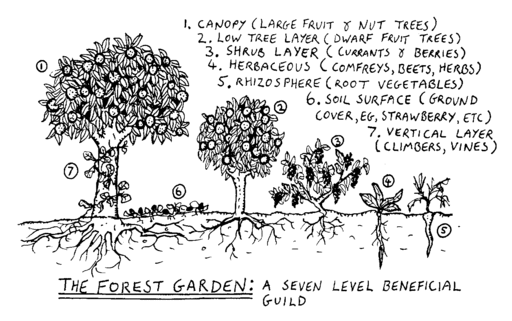Blog by Joanna Chin, Doctoral Student, York University-Environmental Studies
Robert Hart, a pioneer of forest gardening in the UK, had a vision of forest gardening:
“Obviously, few of us are in a position to restore the forests. But tens of millions of us have gardens or access to open spaces such as industrial wasteland, where trees can be planted and if full advantage can be taken of the potentialities that are available in heavily built up areas, new city forests can arise…”
Through Hart’s observations of the complex relationships and interactions in his woodland forest garden, he developed a 7-layered model of forest gardens.
- A canopy layer that consists of tall fruit and nut trees.
- A lower tree layer of dwarf fruit and nut trees.
- A shrub layer of fruit bushes such as currants and berries.
- An herbaceous layer of culinary and medicinal herbs, companion plants, bee- and poultry- loving plants.
- A ground cover of edible plants that function as a living mulch.
- A rhizosphere layer that consists of root crops.
- A vertical layer of vines and climbers.

Forest Garden Diagram by Diagram by Graham Burnet. Image via Wikimedia Commons licensed under GNU Free Documentation License
Bill Mollison, who many consider the founding father of permaculture – ecological and environmental design that reconciles food production systems and human settlements, with nature – visited Hart at his forest garden in Wenlock Edge. Following his visit, forest gardens became one of the key concepts in permaculture.
Food forests integrate and draw from the disciplines of permaculture, agriculture, ecology, biology and other natural living sciences. Together, these disciplines create a living set of tools and practices that can help us engage in regenerative garden design at multiple scales. A diverse community of life can grow in a small space, which is suitable for urban environments. “Biophilia” developed by the late professor of social ecology, Stephen Kellert, suggests that humanity’s innate connection to nature transcends our physical and material reliance on the natural world. Food Forests can regenerate urban spaces through sustainable food production. And at a deeper individual level, the practice of food forestry can help us cultivate ourselves, and transform the ways in which we see and live in the world.
Stay tuned for my next post on why I got into Community Food Forestry.
- Log in to post comments


CRC Comments